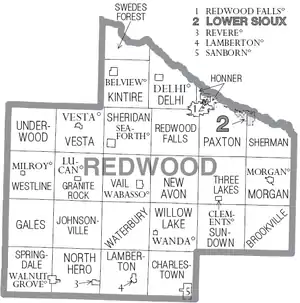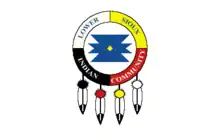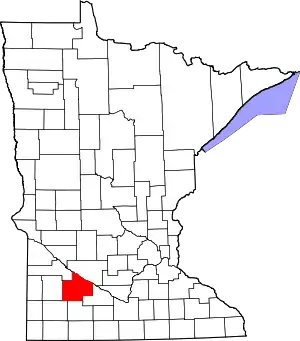Lower Sioux Indian Reservation
The Lower Sioux Indian Reservation, (Dakota: Cansa'yapi; Lakota: Čhaŋšáyapi[1]) also known as the Mdewakanton Tribal Reservation, is an Indian reservation located along the southern bank of the Minnesota River in Paxton and Sherman townships in Redwood County, Minnesota. Its administrative headquarters is two miles south of Morton. The reservation is located southeast of Redwood Falls, the county seat.

The area was established as part of a reservation for the Mdewakanton and Wahpekute bands of the Lower Sioux under the Treaty of Traverse des Sioux in 1851 with the federal government. It originally extended about 70 miles (110 km) along the Minnesota River and was 20 miles (30 km) wide. It was greatly reduced following the Dakota War of 1862 and various other actions. As of the 2000 census, this lower reservation had a population of 335, and a land area of 2.705 sq mi (7.006 km²).
History
The area around the reservation is primarily rural, developed in the 21st century for agricultural commodity crops of corn and soybeans. The conversion of area creeks to agricultural ditches has also altered habitat and reduced the diversity of the ecology.
Termination efforts
From the 1940s to the 1960s, the United States government (including Congress) had a policy of terminating tribes, that is, ending the special relationships that they had with the federal government. The belief was that tribes would be selected that appeared to have adapted successfully to mainstream culture: in the process, any communal land would be distributed to individual households, and individuals would become residents of their respective counties and states, and under their jurisdiction.
Four Native American tribes (each associated with separate reservations) in Minnesota were identified for termination in the 1950s. A memo dated January 19, 1955 for the BIA issued from the Department of the Interior indicates additional terminations were being reviewed in proposed legislation for what were primarily Dakota tribes in southern Minnesota, including the Lower Sioux Community in Redwood and Scott counties, the New Upper Sioux Community in Yellow Medicine County, the Prairie Island Community in Goodhue County, and about 15 individuals living on restricted tracts in Yellow Medicine County.[2]
Discussions between the BIA and the tribal Indians from the targeted area began in 1953 and continued throughout 1954. Though the Prairie Island and Lower Sioux communities drafted agreements for distribution of land to individual households and ownership, the Upper Sioux strongly opposed fee-simple title to tribal lands. On January 26, 1955 Senator Edward Thye introduced a bill (S704) to provide for termination of the tribes. In addition to opposition by the Dakota, regional residents objected to termination, saying that county and state expenditures might increase for the areas then within reservations, and they expressed their opposition to the committee reviewing the bill. The Minnesota Governor's Commission on Human Rights also opposed the legislation, indicating that it would "not adequately protect the interests of the Indians...". The bill died in committee, never reaching the Senate floor.[3]
Tribal enterprises

The Mdewakanton tribe operates Jackpot Junction Casino Hotel, which began in 1984 as a bingo facility. The casino has become a major employer for the surrounding communities. The Lower Sioux Agency, a historic site on the reservation associated with the Dakota War of 1862, is managed by the community in partnership with the Minnesota Historical Society.[4]
Jackpot Junction Casino Hotel was the state of Minnesota's first casino. In addition to the gaming areas, Jackpot Junction features three bars, three restaurants, an amphitheater for live performances, and two grand ballrooms. Live music is played every weekend, usually country and occasionally rock. The casino is open twenty-four hours a day, seven days a week.
County Highway 2 runs through the reservation, connecting it to U.S. Route 71 and Minnesota State Highway 19 to the northwest.
See also
References
- Ullrich, Jan, ed. (2011). New Lakota Dictionary (2nd ed.). Bloomington, IN: Lakota Language Consortium. p. 999. ISBN 978-0-9761082-9-0. LCCN 2008922508.
- "Proposed Terminal Legislation for Indians of Southern Minnesota" (PDF). Department of the Interior. Archived from the original (PDF) on June 10, 2014. Retrieved December 29, 2014.
- >Meyer, Roy Willard (1993). "History of the Santee Sioux: United States Indian Policy on Trial". University of Nebraska Press. p. 354. ISBN 0-8032-8203-6. Retrieved December 19, 2014.
- "Lower Sioux Agency". Minnesota Historical Society. Retrieved October 1, 2013.
External links
- Official website
- Lower Sioux Reservation, Minnesota United States Census Bureau
- "Lower Sioux--'Can 'sayapi", Minnesota Indian Affairs Council
